
Every person is unique!
Our experienced team will be happy to advise you in detail and free of charge on all matters relating to your health. Book your consultation appointment now:
Chaga - the strong "Pearl of the North
April 20, 2021
Dr. Dorothee Bös et al.
High in the north, where winters are freezing, the Chaga medicinal mushroom feels at home. Due to its resistance to cold and its symbiosis with the medicinal birch, it is rich in valuable substances that also benefit human health. Traditionally, it has been used for centuries to treat gastrointestinal problems and even cancer.
Where does the Chaga come from?
According to old Russian reports, around the year 1100 a Ukrainian grand prince fell seriously ill with lip cancer. His doctor prescribed him a course of treatment with the Chaga medicinal mushroom. At that time, the cancer is said to have completely disappeared solely due to this alternative medical remedy.
This report coincides with the experience of doctors in some regions of Finland and Russia: in Lapland and Siberia, the locals like to drink a tea made from the vital mushroom every day. It seems to be more than a coincidence that cancers are quite rare in these regions. Thus, Chaga has had a reputation as an immune-boosting vital mushroom for centuries and has been on the official Russian medicinal list since 1858. In the 1930s, scientists finally began intensive research into the exact active ingredients in Chaga. Their findings in relation to tumors and other diseases will be presented to you in detail in a moment.
The Chaga medicinal mushroom in folk medicine
Taxonomically, the Chaga belongs to the genus of Schillerporlinge. The name of the medicinal mushroom is pronounced “Tschaga” in German. Sometimes it can be found in the literature directly under this phonetic term. In Russia, where it is an important vital mushroom in the treatment of cancer, it is spelled “Czaga”. Its name in Latin is “Inonotus obliquus”. In literature as well as among mycologists, you will also come across the names “Schiefer Schillerporling”, “Birkenpilz” and sometimes even “Perle des Nordens”.
Here already sounds that the Chaga medicinal mushroom grows preferentially in northern climes as well as on birch trees. In folk medicine, by the way, it is also known as a tonic, which is used for gastrointestinal as well as lung diseases. In addition, it can reduce excessive hunger pangs and has been shown to help with various skin conditions.
Unlike many other medicinal mushrooms 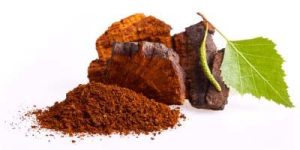 , it is not the fruiting body itself that is used by the Chaga for naturopathic purposes, but the secondary fruiting body visible on the outside of the birch, also called the permanent form or “sclerotium”. The mycelium also contains many valuable substances that can promote human health and even push back tumors. Together with the actual fruiting body, it can now be grown very well. Only the sclerotia cannot be grown under artificial conditions so far. That is why these come exclusively from wild collections. Mycotherapists like to administer a mixture of the wild accessory fruit bodies and the cultivated mycelium.
, it is not the fruiting body itself that is used by the Chaga for naturopathic purposes, but the secondary fruiting body visible on the outside of the birch, also called the permanent form or “sclerotium”. The mycelium also contains many valuable substances that can promote human health and even push back tumors. Together with the actual fruiting body, it can now be grown very well. Only the sclerotia cannot be grown under artificial conditions so far. That is why these come exclusively from wild collections. Mycotherapists like to administer a mixture of the wild accessory fruit bodies and the cultivated mycelium.
When choosing a Chaga preparation, be sure to always pay attention to its origin! Indeed, fungi have the potential to store environmental toxins and even radioactivity. Therefore, you should be sure that your Chaga comes from unspoiled nature, such as the north of Finland, Norway or Canada, or from an organic farm. The mycelium should also be grown according to organic farming guidelines. Only then is it free of substances that are harmful to health.
Slate Schillerporling - a real fountain of health
Another important point regarding the origin of the vital mushroom Chaga concerns the winter temperatures: the greater the cold that a slate schiller porling has to brave during its life, the more vital substances it forms inside. It can withstand temperatures as low as -40 ° Celsius, which is quite common near the Arctic Circle. Thus, some of the substances of medicinal interest are formed by the Chaga out of the need to protect itself from adverse environmental conditions.
Which substances are found exclusively in the Chaga medicinal mushroom?
Although chaga can grow on a variety of deciduous trees, several species of birch are its common host trees. This preference results in a wonderful symbiosis for the healing power of chaga: namely, birch itself is considered a medicinal tree that can effectively support the detoxification and purification of our body and is popularly used for rheumatic complaints. It has valuable substances that the vital mushroom absorbs in the course of its growth. One of these is betulin, a precursor of betulinic acid. This is usually found in the white bark of birch and accumulates in the chaga. Scientists suspect that betulin plays a significant role in the antitumor effect of the medicinal mushroom.
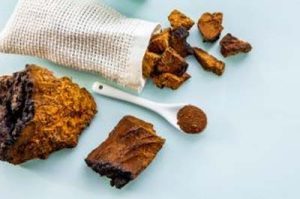 Only then can you be sure of all the healing substances mentioned here. In addition to betulin, a cytostatic mode of action is also attributed to inotodiol. This anti-inflammatory sterol is also typical of Chaga and contributes significantly to its health-promoting effects.
You may have noticed that the sclerotia of Chaga are almost pitch black. They are somewhat reminiscent of coal or a black ulcer – this is probably how people became aware of the fungus and its properties. This is due to the fact that the crooked schillerporling is rich in the dark pigment melanin. We even produce this substance in our body ourselves when we tan. Melanin is extremely valuable for our health because, among other things, it has a strong antioxidant effect and thus counteracts inflammatory as well as aging processes. It is also heat resistant.
Only then can you be sure of all the healing substances mentioned here. In addition to betulin, a cytostatic mode of action is also attributed to inotodiol. This anti-inflammatory sterol is also typical of Chaga and contributes significantly to its health-promoting effects.
You may have noticed that the sclerotia of Chaga are almost pitch black. They are somewhat reminiscent of coal or a black ulcer – this is probably how people became aware of the fungus and its properties. This is due to the fact that the crooked schillerporling is rich in the dark pigment melanin. We even produce this substance in our body ourselves when we tan. Melanin is extremely valuable for our health because, among other things, it has a strong antioxidant effect and thus counteracts inflammatory as well as aging processes. It is also heat resistant. Simply request free information brochures now!
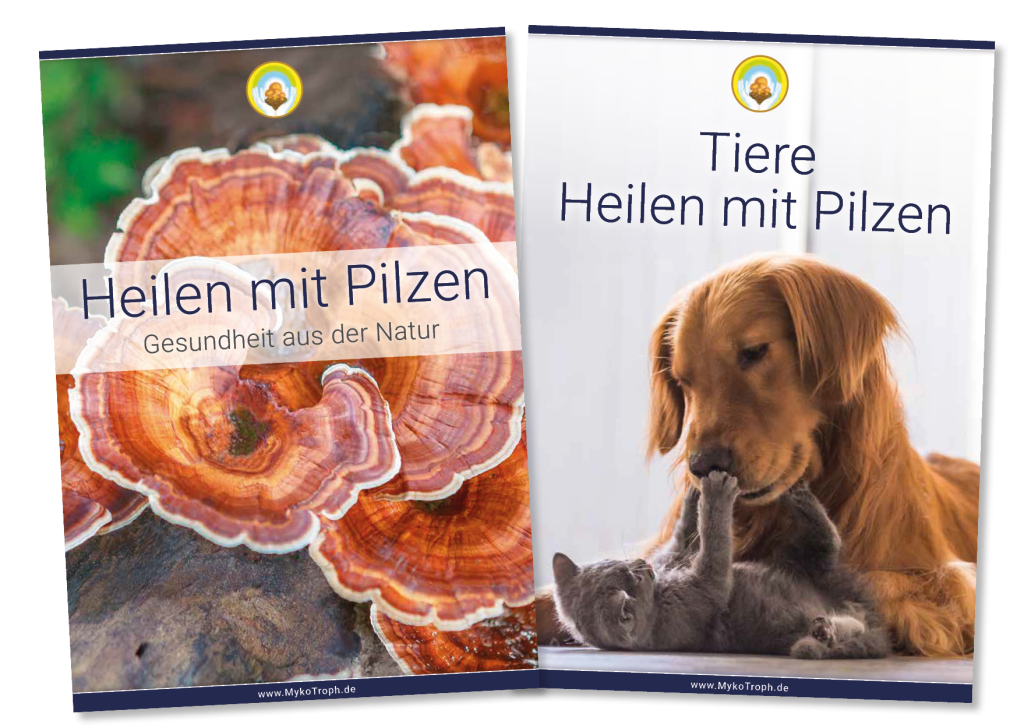
After you have sent the completed form, you will receive an e-mail with a download link.
Other valuable substances
As a vital mushroom, the slanting schillerporling also contains various other substances that can promote and maintain the health of humans and animals. One group of these substances that has recently attracted increasing interest from researchers are polysaccharides. These long-chain carbohydrates not only have a positive effect on our intestinal flora, they are also able to alleviate inflammation and oxidative stress. One particularly well-known polysaccharide compound is beta-glucan. It is also present in Chaga and explains many of its medicinal properties such as immunomodulatory effects.
In addition, the vital mushroom brings antioxidant enzymes such as superoxide dismutase, and also regenerates glutathione and superoxide dismutase levels in the body in a very short time – an important mechanism against dementia and other diseases with oxidative stress. In addition, the Chaga has excellent ORAC values. Its triterpenes are also an important support for the human immune system, while its flavonoids are another pillar in the treatment of tumors. In addition, flavonoids are also believed to have antioxidant properties as secondary metabolites. In addition to the already mentioned inotodiol, other medically effective sterols such as lanosterol and ergosterol are found in Chaga.
Micro and macronutrients
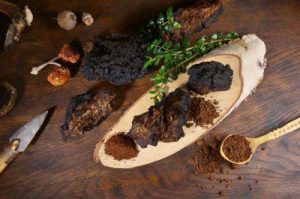 In addition, it has many different amino acids in it – including numerous essential amino acids, which we can supply our body exclusively through our food. Scientists believe that Chaga contains a total of over 200 bioactive substances that have a positive effect on our health. To date, however, only a fraction of these are known and even less has been researched with regard to their precise mechanisms of action.
In addition, it has many different amino acids in it – including numerous essential amino acids, which we can supply our body exclusively through our food. Scientists believe that Chaga contains a total of over 200 bioactive substances that have a positive effect on our health. To date, however, only a fraction of these are known and even less has been researched with regard to their precise mechanisms of action. Traditional and modern applications of Chaga
Due to the diversity of its healthy ingredients, the spectrum in which the Chaga medicinal mushroom is used is broad. In addition to its traditional uses as a tonic, anti-cancer agent and tonic for the gastrointestinal tract, modern mycotherapy has discovered it to be a valuable remedy for hypertension, diabetes, fibromyalgia, allergies, viral diseases and various skin problems, for example. We have embedded the central areas of application of the Chaga medicinal mushroom in current research results for you below.
Support for the immune system
 On the one hand, it stimulates the immune system itself to increased activity. In addition, some of its ingredients have antiviral and antibacterial effects. On the other hand, it has a calming effect on an overshooting immune system as we find in autoimmune diseases. Researchers attribute this immunomodulatory effect to beta-glucans, among other things. They attach themselves to the white blood cells (leukocytes), which stimulates them to increased activity. In addition, leukocytes exhibit a longer lifespan in the presence of beta-glucans.
The direct antiviral mode of action of Chaga is remarkable: it has the potential to prevent the multiplication of certain viruses. Studies have demonstrated corresponding effects on influenza viruses, feline panleukopenia, hepatitis C, and herpes simplex, among others. In the case of the herpes virus, a slate schillerporling has even been able to prevent infection in the laboratory. A central role in these effects is thought to be played by the inotodiol. Studies showed that it impedes the spread of flu viruses, for example. It could have a similar effect on HIV. It also stimulates the immune system in general. Initial evidence also suggests that other bioactive molecules from the Chaga medicinal mushroom inhibit certain messenger substances in the body that are responsible for inflammation.
On the one hand, it stimulates the immune system itself to increased activity. In addition, some of its ingredients have antiviral and antibacterial effects. On the other hand, it has a calming effect on an overshooting immune system as we find in autoimmune diseases. Researchers attribute this immunomodulatory effect to beta-glucans, among other things. They attach themselves to the white blood cells (leukocytes), which stimulates them to increased activity. In addition, leukocytes exhibit a longer lifespan in the presence of beta-glucans.
The direct antiviral mode of action of Chaga is remarkable: it has the potential to prevent the multiplication of certain viruses. Studies have demonstrated corresponding effects on influenza viruses, feline panleukopenia, hepatitis C, and herpes simplex, among others. In the case of the herpes virus, a slate schillerporling has even been able to prevent infection in the laboratory. A central role in these effects is thought to be played by the inotodiol. Studies showed that it impedes the spread of flu viruses, for example. It could have a similar effect on HIV. It also stimulates the immune system in general. Initial evidence also suggests that other bioactive molecules from the Chaga medicinal mushroom inhibit certain messenger substances in the body that are responsible for inflammation. Focus: Toxoplasmosis
An interesting finding on the Chaga medicinal mushroom comes from research on pregnant mice infected with toxoplasmosis. This is a parasitic infection that is usually only dangerous for cats. Exclusively at the end of pregnancy, toxoplasmosis also poses a risk to other mammals such as humans. The administration of Chaga has now prevented the frequently observed drop in progesterone and estrogen in mice. Furthermore, the number of miscarriages was lower than in the infected mice that did not receive vital mushroom. The researchers also observed a decrease in TNF-alpha and other inflammatory messengers and an increase in endogenous antioxidants. All in all, the Chaga medicinal mushroom probably supports the pregnant organism to better cope with an infestation of toxoplasmosis.
Natural remedies against cancer
In Russia, Poland and the Baltic states, the slanting Schillerporling is a widely recognized remedy for cancer. In Russia, it has been on the official list of medicines for over 150 years. Today, Russian doctors usually prescribe it when conventional medicine is ineffective against cancer. Its tumor-inhibiting effect was first proven by a Polish physician and professor in 1954. Since then, physicians worldwide have been studying the vital mushroom and its antitumor potential.
Preventive use
In this country, mycotherapists recommend taking chaga primarily as a preventative measure. Due to its strong antioxidant properties, it protects cell DNA from free radical damage. The betulin from birch bark acts as a particularly effective radical scavenger, while also stimulating the production of interferons, which are instrumental in repairing already damaged cell DNA.
Cancer therapy
 However, clear effects have also been observed in other cancers, for example breast, liver and uterus. Taken at an early stage, it helps to impede the formation of metastases. However, even in advanced tumor disease, taking Chaga can slow down the growth. For example, in a study on mice suffering from skin cancer, betulin showed a remarkable effect. As soon as it entered a cancer cell, it died. The researchers found that it has such an effect exclusively on tumor cells because of the difference in pH.
In addition to betulin, inotodiol also has the potential to induce tumor cell death. Researchers believe that the polyphenols, triterpenes and melanin from the Chaga medicinal mushroom also play a part in the antitumor effect.
However, clear effects have also been observed in other cancers, for example breast, liver and uterus. Taken at an early stage, it helps to impede the formation of metastases. However, even in advanced tumor disease, taking Chaga can slow down the growth. For example, in a study on mice suffering from skin cancer, betulin showed a remarkable effect. As soon as it entered a cancer cell, it died. The researchers found that it has such an effect exclusively on tumor cells because of the difference in pH.
In addition to betulin, inotodiol also has the potential to induce tumor cell death. Researchers believe that the polyphenols, triterpenes and melanin from the Chaga medicinal mushroom also play a part in the antitumor effect. Metabolism and inflammation
Inflammation is often associated with infections and many other diseases. Poor nutrition and the resulting unfavorable metabolic processes can also be causative factors for inflammation in the body. For example, diabetics have relatively high levels of inflammation on average. For them, Chaga has a favorable combination of effects: anti-inflammatory, blood sugar, uric acid and blood pressure lowering. The far-reaching influence of the medicinal mushroom on the metabolism is also shown by a study on mice fed a high-fat diet. The mice that were given the Chaga in addition to the nutritious diet hardly gained any weight and accordingly did not suffer from the secondary diseases that their peers without the vital mushroom exhibited.
Causes and consequences of chronic inflammation can be, for example, arteriosclerosis, autoimmune diseases and various complaints in the context of a metabolic syndrome. From all these consequences, the crooked schillerporling offers some protection. Its polysaccharides in particular help the immune system to reduce inflammation. In practice for this reason again and again positive effects of the vital mushroom are observed among other things on chronically inflammatory intestine illnesses, multiple sclerosis and Morbus Bechterew.
At this point, another reference to the host tree of the crooked birch bark fungus is appropriate: In particular, the white part of the birch bark provides relief from various inflammatory diseases such as rheumatism, pancreatitis (inflammation of the pancreas) and endometritis (inflammation of the uterus). It is therefore hardly surprising that the crooked schillerporling has proven its therapeutic value in the past for exactly the same ailments.
Strengthen the gastrointestinal tract
Slate Schillerporling for healthy skin

- Psoriasis (psoriasis)
- Neurodermatitis
- allergic skin reactions
- Acne
- Age spots
- dry-scaly skin
Use for allergies
Other traditional areas of application for Chaga
- Bronchitis and asthma
- Tuberculosis
- Abdominal pain and digestive problems
- Periodontosis
- Hemorrhoids
- Parasites
- Liver and heart problems
Tips and information about the vital mushroom Chaga
How does Chaga grow?
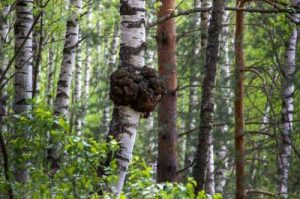 It is also found in extensive birch woodland swamps in Mongolia, northern China, Korea, Japan and Canada. It prefers to grow on mature birch trees, but can also thrive on alder, beech and other deciduous trees. As a vital mushroom traditionally serves only chaga, which grows on the birch.
Chaga grows very slowly and may well spend 20, sometimes even 40 years with its tree. During this time it forms its sclerotium, which protrudes from the tree like a black ulcer. Depending on its age, it reaches a diameter of a good half meter and up to five kilograms in weight. While it is brittle and hard on the outside, the inside has a yellowish-brown color. Only when the tree dies, the Schiefe Schillerporling forms its actual fruiting body. This can become quite large. As soon as the fruiting body is ripe, it releases its spores. On it then the entire fungus decays within a few days.
It is also found in extensive birch woodland swamps in Mongolia, northern China, Korea, Japan and Canada. It prefers to grow on mature birch trees, but can also thrive on alder, beech and other deciduous trees. As a vital mushroom traditionally serves only chaga, which grows on the birch.
Chaga grows very slowly and may well spend 20, sometimes even 40 years with its tree. During this time it forms its sclerotium, which protrudes from the tree like a black ulcer. Depending on its age, it reaches a diameter of a good half meter and up to five kilograms in weight. While it is brittle and hard on the outside, the inside has a yellowish-brown color. Only when the tree dies, the Schiefe Schillerporling forms its actual fruiting body. This can become quite large. As soon as the fruiting body is ripe, it releases its spores. On it then the entire fungus decays within a few days. How do I take the Chaga medicinal mushroom?
We have already mentioned that when choosing a Chaga preparation, you should pay close attention to its origin and thus quality. 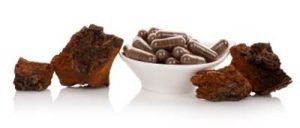 A gentle manufacturing process at temperatures below 40° Celsius is also important to preserve all valuable enzymes in their full activity. While tea is considered to be the traditional form of administration of Chaga, nowadays the mushroom powder is preferred as the ideal natural remedy for the reason mentioned above. Although Chaga has kidney-protecting properties, people with a tendency to oxalate stones should not take high doses of Chaga tea or powder and should always seek advice first.
A gentle manufacturing process at temperatures below 40° Celsius is also important to preserve all valuable enzymes in their full activity. While tea is considered to be the traditional form of administration of Chaga, nowadays the mushroom powder is preferred as the ideal natural remedy for the reason mentioned above. Although Chaga has kidney-protecting properties, people with a tendency to oxalate stones should not take high doses of Chaga tea or powder and should always seek advice first.
Powder in capsules is the easiest to dose. Here, moreover, you can be quite sure of the durability. How many capsules you should take in your individual case depends on your condition, physical constitution and other life circumstances. It is therefore impossible to make a blanket statement here. Therefore, feel free to consult our experts and get detailed advice. In many cases, a combination with other medicinal mushrooms or measures is also suitable. We will be happy to provide you with comprehensive information on this.
For mushroom powders there are many suppliers
You will find trustworthy suppliers with controlled organic cultivation in Germany, but unfortunately also less recommendable importers of cheap goods. Read what is important when buying.
DO YOU HAVE ANY QUESTIONS?
We will gladly take time for you. In our free consultation we answer individually and personally all your health questions under:

Every person is unique!
Our experienced team will be happy to advise you in detail and free of charge on all matters relating to your health.
Scientific studies / sources
- http://www.dl.begellhouse.com/journals/708ae68d64b17c52,31e1791e300b7e1e,3286d9910025fd97.html, Anticancer Effects of Fraction Isolated from Fruiting Bodies of Chaga Medicinal Mushroom, Inonotus obliquus (Pers.:Fr.). Pilát (Aphyllophoromycetideae): In Vitro Studies
- https://link.springer.com/article/10.3839/jksabc.2011.016, In Vitro Investigation on Antioxidative Effect of Inonotus obliquusExtracts against Oxidative Stress on PC12 Cells.
- Progress on Understanding the Anticancer Mechanisms of Medicinal Mushroom: Inonotus Obliquus.
- http://www.koreascience.or.kr/article/JAKO201321365237667.page
- Melanins of Inonotus obliquus: bifidogenic and antioxidant properties, MA Burmasova, AA Utebaeva, EV Sysoeva… – Biomolecules, 2019.
- http://www.koreascience.or.kr/article/JAKO201321365237667.page, Progress on Understanding the Anticancer Mechanisms of Medicinal Mushroom: Inonotus Obliquus.
- Inonotus obliquus polysaccharide protects against adverse pregnancy caused by Toxoplasma gondii infection through regulating Th17/Treg balance via TLR4/NF-κB pathway
- https://www.sciencedirect.com/science/article/pii/S0141813019370345
